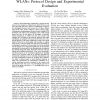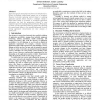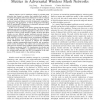113
click to vote
SECON
2008
IEEE
15 years 6 months ago
2008
IEEE
—We describe and evaluate a suite of distributed and computationally efficient algorithms for solving a class of convex optimization problems in wireless sensor networks. The pr...
110
click to vote
SECON
2008
IEEE
15 years 6 months ago
2008
IEEE
—Delay Tolerant Networks are wireless networks where disconnections may occur frequently due to propagation phenomena, node mobility, and power outages. Propagation delays may al...
106
Voted
SECON
2008
IEEE
15 years 6 months ago
2008
IEEE
—Fast proliferation of IEEE 802.11 wireless devices has led to the emergence of High-Density (HD) Wireless Local Area Networks (WLANs), where it is challenging to improve the thr...
SECON
2008
IEEE
15 years 6 months ago
2008
IEEE
Application specific tuning has been shown to be beneficial for a variety of platforms, sensor-based systems are no exception. However, accurately capturing external stimuli or mo...
SECON
2008
IEEE
15 years 6 months ago
2008
IEEE
—Energy-efficient performance is a central challenge in sensor network deployments, and the radio is a major contributor to overall energy node consumption. Current energyeffic...
102
click to vote
SECON
2008
IEEE
15 years 6 months ago
2008
IEEE
Abstract—Besides safe navigation (e.g., warning of approaching vehicles), car to car communications will enable a host of new applications, ranging from office-on-the-wheel supp...
108
click to vote
SECON
2008
IEEE
15 years 6 months ago
2008
IEEE
—Recent work in multicast routing for wireless mesh networks has focused on metrics that estimate link quality to maximize throughput. Nodes must collaborate in order to compute ...
102
click to vote
SECON
2008
IEEE
15 years 6 months ago
2008
IEEE
— We address the problem of congestion control in multi-radio, multi-channel, wireless mesh networks. Compared to its single radio counterpart for which solutions exist, this pro...
SECON
2008
IEEE
15 years 6 months ago
2008
IEEE
—Deployment of Wireless Mesh Networks (WMNs) is becoming increasingly popular due to the low-impact and lowcost features of wireless devices. This is especially true for WMNs bas...
98
Voted
SECON
2008
IEEE
15 years 6 months ago
2008
IEEE
—Traditional rate adaptation solutions for IEEE 802.11 wireless networks perform poorly in congested networks. Measurement studies show that congestion in a wireless network lead...




